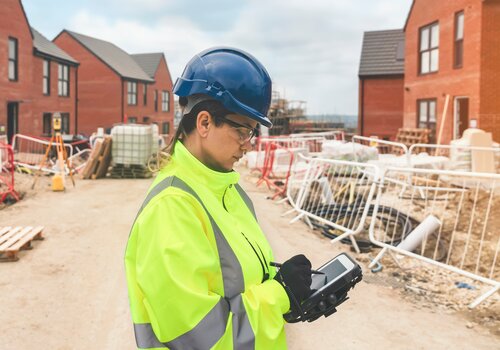In today’s increasingly digital world, construction contractors face a growing number of cyber threats that can disrupt operations, threaten sensitive data and damage hard-earned reputations. The construction industry is often seen as an easy target due to its diverse supply chain, heavy reliance on third-party vendors, and the use of specialized software for project management, billing and equipment tracking.
Cybersecurity threats is the top worry for the construction industry, according to a recent study that shows 42 percent of participants are “most worried” about cybersecurity and 40 percent saying it is the risk they are most unprepared for.
With the global average cost of a data breach costing $4.45 million and taking 277 days to identify and contain, it is no wonder so many are worried. But like most threats, being proactive today can save time and money later.
Here are five ways construction contractors can enhance cybersecurity and safeguard their business operations.
1. IMPLEMENT STRONG ACCESS CONTROLS AND AUTHENTICATION
The first step to enhancing cybersecurity is ensuring that only authorized personnel can access critical systems and data. Construction companies often have large teams working across multiple locations and platforms, making it essential to control who has access to what.
Here are some key practices for access control.
Role-based access: Limit access based on job roles, ensuring that employees can only access information they need to perform their duties. For instance, your project managers may need access to scheduling and budgeting software, but not payroll systems.
Two-factor authentication (2FA): This adds an additional layer of security by requiring users to verify their identity using a second form of authentication, such as a code sent to their mobile device, in addition to their password.
Password management policies: Require employees to create strong, unique passwords that are changed regularly. Password management tools can also help employees store and manage credentials securely.
Strong access control and authentication protocols help prevent unauthorized users from gaining access to sensitive company data, which can be critical for protecting against cyberattacks like data breaches and ransomware.
2. REGULARLY UPDATE SOFTWARE AND SYSTEMS
Cybercriminals often exploit vulnerabilities in outdated software to infiltrate systems. Construction contractors frequently use a variety of software, from accounting programs to project management platforms, and these need to be kept up to date.
Here are some best practices for software updates.
Automate updates: Set up automated software updates to ensure that all systems are running the latest versions with the latest security patches. This applies to everything from operating systems to specialized construction software.
Patch management: Regularly check for and apply security patches to close any vulnerabilities. A patch management system can help automate this process and ensure nothing is overlooked.
Vendor updates: Stay in touch with your software vendors to ensure you’re aware of any potential security issues or updates. This is particularly important for any third-party tools or cloud-based platforms you may use for managing projects or communications.
By keeping software and systems updated, you reduce the risk of attackers exploiting known vulnerabilities and entering your network.
Cybersecurity threats is the top worry for the construction industry, according to a recent study that shows 42 percent of participants are “most worried” about cybersecurity and 40 percent saying it is the risk they are most unprepared for.
3. TRAIN EMPLOYEES ON CYBERSECURITY BEST PRACTICES
Your employees are the first line of defense against cyber threats, and often the weakest link. Cyberattacks like phishing scams, where attackers trick users into divulging sensitive information, rely on human error. A single click on a malicious link can lead to significant breaches, ransomware infections or data theft.
Here are some tips improve employee cybersecurity awareness.
Regular training: Conduct ongoing cybersecurity training sessions for all employees, from the office to the job site. Training should include how to identify phishing emails, how to handle sensitive information and what to do if they suspect a security breach.
Simulated attacks: Run regular phishing simulations to assess how well your employees are following cybersecurity protocols. These tests can help you identify areas where further training is needed.
Clear reporting procedures: Establish and communicate clear procedures for reporting suspected cyber incidents. Employees should know who to contact if they encounter a potential threat, and response plans should be in place to act quickly.
Cybersecurity training empowers employees to recognize and respond to potential threats, significantly reducing the risk of a successful attack. Hackers are increasing their reach and sending links that look legitimate, with an increase of 130% for the first quarter of 2024 compared to 2023. It takes just one person to click on the wrong link to put all your data at risk. The time spent training all employees can help prevent your company from being exposed.
4. Implement a Comprehensive Data Backup Strategy
Data is an asset for any construction contractor and ensuring that it is regularly backed up is essential for business continuity in the event of a cyberattack. Ransomware, which locks users out of their data until a ransom is paid, can be particularly devastating for companies that don’t have adequate backups in place.
Steps to develop a solid data backup strategy:
Regular backups: Schedule regular backups of critical systems and data. Daily backups may be appropriate for financial and project management data, while less critical information can be backed up weekly.
Offsite and cloud backups: Store backups in a secure offsite location or in the cloud. This ensures that even if your physical systems are compromised, you have an accessible copy of your data. Cloud backup services can also provide encryption for an added layer of security.
Test recovery plans: It’s not enough to back up your data; you need to ensure that your backups work. Regularly test your recovery processes to ensure you can quickly restore data in the event of a loss.
Having a comprehensive data backup strategy minimizes downtime and prevents data loss, ensuring that your construction projects can continue even after a cyberattack.
5. Secure Mobile Devices and Remote Work
Construction work is increasingly mobile, with project managers, site supervisors and other personnel accessing company systems from smartphones, tablets and laptops. Remote access and the use of personal devices introduce additional security risks.
Here are ways to secure mobile devices and remote work.
Mobile device management (MDM): Implement an MDM solution to monitor, manage and secure mobile devices used by employees. These tools can enforce security policies, such as requiring device encryption or wiping data remotely if a device is lost or stolen.
VPN for remote access: Require employees to use a virtual private network (VPN) when accessing company systems from remote locations. A VPN encrypts data and creates a secure connection, reducing the risk of interception.
Device encryption: Ensure that all mobile devices and laptops used for work are encrypted to protect sensitive data in the event of loss or theft.
With more construction professionals working remotely or on the move, securing mobile devices and remote access points is critical for maintaining cybersecurity.
As cyber threats continue to evolve, construction contractors should take proactive steps to secure their systems, data and operations. By prioritizing these steps, contractors can protect their businesses from costly cyberattacks and maintain the trust of their clients, partners and employees.
Photo credit: KOKLIANG/BIGSTOCKPHOTO.COM












